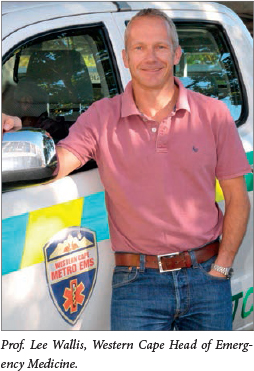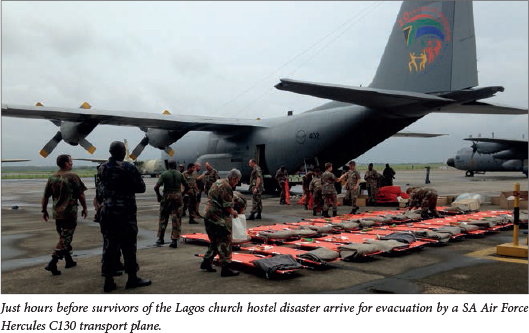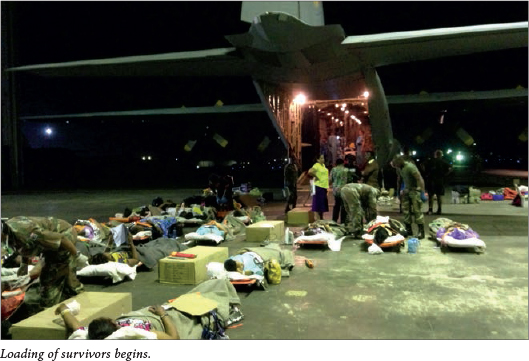Serviços Personalizados
Artigo
Indicadores
Links relacionados
-
 Citado por Google
Citado por Google -
 Similares em Google
Similares em Google
Compartilhar
SAMJ: South African Medical Journal
versão On-line ISSN 2078-5135
versão impressa ISSN 0256-9574
SAMJ, S. Afr. med. j. vol.104 no.11 Pretoria Nov. 2014
http://dx.doi.org/10.7196/SAMJ.8989
IZINDABA
Emergency care doctors - 'off-task and in the wrong places'
It's virtually impossible to calculate whether South Africa (SA) has a shortage of emergency care doctors and nurses until they are properly deployed to where the greatest needs are - and have sufficient ancillary support to ensure that they don't spend chunks of their time doing 'other people's jobs'.

This is the view of Prof. Lee Wallis, head of the emergency medicine divisions of the universities of Cape Town and Stellenbosch and Western Cape Head of Emergency Medicine. Appointed in 2012 by national health minister Dr Aaron Motsoaledi to chair a committee reviewing emergency care nationally, Wallis spent over a year methodically visiting emergency centres across the length and breadth of the country. This September he also co-led the largest-ever peacetime evacuation of its citizens by an SA Defence Force medical team - the repatriation of the 25 survivors of the tragic Nigerian Pentecostal church hostel collapse in Lagos that claimed 85 of their compatriots among the 115 killed.
Izindaba called Wallis to test our assumption that SA's lack of emergency doctors and nurses is crippling our ability to deal with our internationally recognised huge burden of violence and trauma. Wallis quickly cautioned against this. He said that SA was actually 'task-shifting the wrong way', resulting in emergency care doctors spending up to 40% of their time doing menial tasks such as clerical duties, portaging patients and answering telephones (as one unpublished internal Western Cape government health quality study at three emergency centres in the relatively well-staffed and equipped Cape Town metropole shows). 'Everybody thinks we need more clinicians, but this [doing inappropriate tasks] is a problem nobody likes to address,' he stressed. The Cape Town study (which suggests that the situation could be infinitely worse in lesser-resourced and staffed emergency centres) also looked at how many minutes it took for a doctor to assess the different levels of injury severity in patients (triage-coded red, orange and green), enabling a rough estimate of how many doctors were needed. The results suggest that 'we don't fully staff our emergency centres' - but more critically that 40% of their actual workload was 'non-value-adding' (the menial tasks referred to earlier). 'If our doctors were doing what they're supposed to be doing all the time, we could quantify the gap much better,' he explained.
Ludicrous deployment
Giving an example of dismally inefficient deployment of emergency care clinicians, Wallis cited two (anonymous) hospitals of roughly the same size, situated cheek-by-jowl, one a district hospital and the other a tertiary. The tertiary hospital had a brand-new emergency centre and four doctors, tending to only about 20 patients daily - because of the strict referral criteria. The doctors and nurses consequently had 'spare time on their hands'. The other nearby (district) hospital had crumbling infrastructure and a casualty ward typical of those at its sister hospitals countrywide. Here, two doctors handled nearly 200 emergency patients per day. 'Probably between those two emergency centres they have close to the right number of doctors, but they are inappropriately placed. Granted it's not this dramatic country wide, but it's clear that the bigger academic centres have better staffing ratios than district hospitals [90% of emergency patients are seen at district hospitals]. We also need to be putting resources closer to where the communities live,' Wallis added, citing the already overburdened but hugely successful modern Khayelitsha Hospital (opened in April 2012) in the eponymous sprawling township outside Cape Town. Asked how the imbalance had developed, he speculated that it was 'probably a throwback to how the balance of power lay and the historical lack of investment in the district health system'.
Mid-level workers will mitigate pressures
Wallis said that because doctors were 'very expensive', the 5-year-old clinical associate training programme (3-year hands-on training) was proving invaluable wherever its graduates were being deployed, KwaZulu-Natal being an early example. Although no data were available yet, surveys in that province showed that 'patients and staff are happier' wherever mid-level medical workers supplemented healthcare staff. 'There's a perception that we can afford doctors, and while that's partly true, we can't retain them when other countries are always paying more. Instead of this spiral of retention of doctors and salary hikes, we should think a bit more cleverly.' His standpoint reflects the government's White Paper on Healthcare Human Resources remedial options of overhauling management (accountability), design (task shifting, as in using mid-level workers such as clinical associates to fill the skills gap between the nurse-based delivery system and doctors), and increased productivity.1 This is preferred over simply hiring more healthcare professionals and clumsily inserting them into the system without an overall needs analysis. Since the clinical associates training programme began at Walter Sisulu University in the Eastern Cape in 2008 (extended to the universities of Pretoria and the Witwatersrand a year later), 408 students have graduated and have been deployed to every province except the better-staffed Western Cape. Another 504 are currently in training at the three campuses. According to John Capiti, Country Director of the American International Health Alliance, which underpins pre-service educational programmes in Africa, the mid-level medical workers can perform 80% of a doctor's tasks (except prescribing drugs, surgery and some other high-level tasks), and 'certainly have an impact on patient waiting times'. Their introduction has aroused predictable controversy in the medical profession, but with a clear scope of practice, supervision and experience they will inevitably help address the healthcare human resource crisis, freeing up doctors in district hospitals to attend outlying clinics and releasing them to handle more complicated cases. For the country as a whole, the doctor-to-population ratio is estimated to be 0.77/1 000. However, because 73% of all GPs work in the private sector, there is just one practising doctor per every 4 219 people for the vast majority of the population. Capiti said that the existing cadre of clinical associates had not yet had an opportunity to work in emergency care, 'but we have a large interest in supporting them [emergency care workers] overall'.

Wallis said that another supplementary strategy would be to base paramedics in emergency centres in the more rural district hospitals - but only when they were not responding to call-outs. 'Normally in rural towns you have nurses seeing these emergency cases and calling in sessional doctors [private GPs] to help,' he explained. Writing in a March 2011 SAMJ editorial,2 Wallis said there was no doubt that trauma was an end-product of multiple complex interactions between education levels, unemployment, poverty, alcohol and drug abuse, poor law enforcement, societal norms and multiple other factors. At a national government level, this complexity and multisectoral nature seemed to be the obstacle to a strong, co-ordinated response: 'it is every ministry's responsibility, hence it appears to be no ministry's responsibility', he wrote. Trauma is the second-commonest cause of death in SA and has millions of living secondary victims, being responsible for up to 40% of hospital emergency centre attendances every year. 'Look a little deeper, and we see that it affects those who potentially have the most to offer to developing societies - the young and healthy,' Wallis added. Reducing the overall rate of trauma was 'critical'. However, no less important (and a whole lot simpler to achieve) was improving the co-ordinated medical care of victims.

Nigerian rescue mission a huge success
Asked about his role in September's evacuation after the Nigerian church hostel collapse, Wallis said that initially he thought that his flying into Lagos 3 days before a specially fitted out Hercules C130 SA air force plane was due to land would put his specialist skills to little practical use. This was because it was well beyond the 72-hour optimal lifesaving window period for seriously injured patients.
However, he was forced to reconsider. The poorly resourced, under-staffed hospitals with limited equipment in Lagos's sprawling shanty towns meant that at least three SA survivors had developed life-threatening complications that he and the military medical team were able to resolve. Wallis, a former British naval officer and battle-hardened medical veteran, said: 'It was touch and go for a while. One man was on dialysis with a spinal injury and proved a challenge to stabilise. A woman had deteriorated very badly with septic shock and was critical by the day we arrived in Lagos. We brought her to the [airport] hangar and the military team spent a good couple of hours trying to stabilise her. Then a third patient developed a haemothorax which had gone undetected and was intensively treated on the flight home, being admitted to Steve Biko Academic Hospital (along with the others) in a dramatically improved condition.'
Flying all night to Lagos, spending 9 hours on the ground, and flying back to Pretoria (again overnight), Wallis said that the five other doctors, three SA National Defence Force commanders, eight paramedics and eight nurses worked incredibly hard to locate, retrieve via muddy, pot-holed township roads, assess and stabilise their precious cargo. He was full of praise for his military counterparts, who he described as 'superbly efficient, well-equipped and a pleasure to work with'. The Hercules C130 aircraft was fitted out with two large intensive care beds and operated as an aerial hospital platform. 'I actually had goose-bumps, I wouldn't be surprised to see that level of expertise and equipment on a British military plane dropping into Iraq.' Wallis knows what he's talking about; he was a medical officer with 40 Commando Royal Marines who secured the Al-Faw Peninsula (Iraq's land-sea oil-tanker hub) in the 2003 allied invasion of Saddam Hussein's Iraq. His contingent 'turned off the oil taps' before fighting their way to Basra, suffering 40 casualties, all of whom he helped treat.
Learning from our disaster responses
Wallis punted the idea of a single SA national emergency response team priori-tising African medical emergencies, adding that setting up a disaster medicine component at the national health department could play ‘a key role in these situations’.
‘I think there’s value in having a senior disaster management person and a clinician to get to the site quickly, do an assessment and provide good on-theground intelligence.’ When called upon to help assemble the Lagos medical evacuation team, he found that many of his colleagues were not up to date with yellow fever injections, effectively ruling them out. ‘We need people available at short notice,’ he stressed. Asked whether his emergency care recommendations to the National Health Committee were being taken up, he said that extending entrylevel training from a 4-week course to a year had been accepted in principle (the minimum requirement for ambulance paramedics). Other suggestions such as expanding emergency medical service staff and locating staff correctly were being ‘taken very seriously’, he added.

Chris Bateman
REFERENCES
1. Bateman, C. Denying reality no longer an option - stark HR report. S Afr Med J 2011;101(10):700-702. [ Links ]
2. Wallis LA. Trauma care in South Africa - a call to arms. S Afr Med J 2011;101(3):171. [ Links ]














